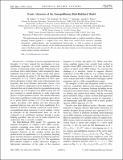Files in this item
Exotic attractors of the non-equilibrium Rabi-Hubbard model
Item metadata
| dc.contributor.author | Schiró, M. | |
| dc.contributor.author | Joshi, C. | |
| dc.contributor.author | Bordyuh, M. | |
| dc.contributor.author | Fazio, R. | |
| dc.contributor.author | Keeling, J. | |
| dc.contributor.author | Türeci, H. E. | |
| dc.date.accessioned | 2016-04-11T17:00:04Z | |
| dc.date.available | 2016-04-11T17:00:04Z | |
| dc.date.issued | 2016-04-08 | |
| dc.identifier | 241583464 | |
| dc.identifier | f6a85374-2e01-428b-a11c-39190d589f0d | |
| dc.identifier | 84963701917 | |
| dc.identifier | 000373587800008 | |
| dc.identifier.citation | Schiró , M , Joshi , C , Bordyuh , M , Fazio , R , Keeling , J & Türeci , H E 2016 , ' Exotic attractors of the non-equilibrium Rabi-Hubbard model ' , Physical Review Letters , vol. 116 , 143603 . https://doi.org/10.1103/PhysRevLett.116.143603 | en |
| dc.identifier.issn | 0031-9007 | |
| dc.identifier.other | ArXiv: http://arxiv.org/abs/1503.04456v1 | |
| dc.identifier.other | ORCID: /0000-0002-4283-552X/work/27559413 | |
| dc.identifier.uri | https://hdl.handle.net/10023/8598 | |
| dc.description.abstract | We explore the phase diagram of the dissipative Rabi-Hubbard model, as could be realized by a Raman-pumping scheme applied to a coupled cavity array. There exist various exotic attractors, including ferroelectric, antiferroelectric, and inccomensurate fixed points, as well as regions of persistent oscillations. Many of these features can be understood analytically by truncating to the two lowest lying states of the Rabi model on each site. We also show that these features survive beyond mean-field, using Matrix Product Operator simulations. | |
| dc.format.extent | 5 | |
| dc.format.extent | 468642 | |
| dc.language.iso | eng | |
| dc.relation.ispartof | Physical Review Letters | en |
| dc.subject | QC Physics | en |
| dc.subject | DAS | en |
| dc.subject.lcc | QC | en |
| dc.title | Exotic attractors of the non-equilibrium Rabi-Hubbard model | en |
| dc.type | Journal article | en |
| dc.contributor.sponsor | EPSRC | en |
| dc.contributor.sponsor | The Leverhulme Trust | en |
| dc.contributor.institution | University of St Andrews. School of Physics and Astronomy | en |
| dc.contributor.institution | University of St Andrews. Condensed Matter Physics | en |
| dc.identifier.doi | 10.1103/PhysRevLett.116.143603 | |
| dc.description.status | Peer reviewed | en |
| dc.identifier.grantnumber | EP/I031014/1 | en |
| dc.identifier.grantnumber | IAF-2014-025 | en |
This item appears in the following Collection(s)
Items in the St Andrews Research Repository are protected by copyright, with all rights reserved, unless otherwise indicated.

